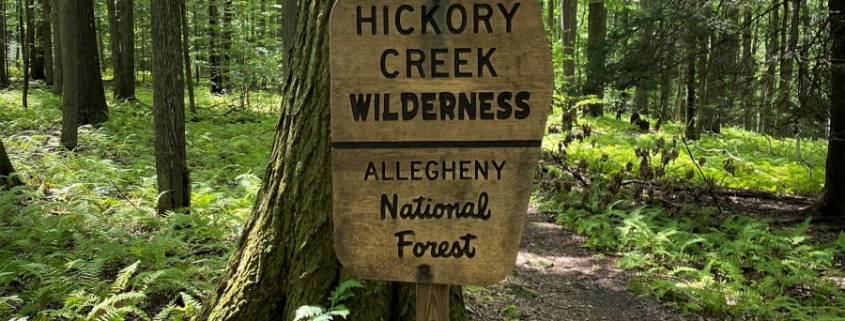Pennsylvania’s Hickory Creek Wilderness
September 7, 2021, I hiked the Hickory Creek Wilderness in the Allegheny National Forest (ANF) in northwest Pennsylvania, about 40 miles west of where I conducted my 1985-86 doctoral research on soil-site relationships in second-growth Allegheny hardwood forests. The Wilderness forests are typical of the greater ANF across the Allegheny Plateau, second-growth and dominated by black cherry, red and sugar maple, mixed oaks, cucumber, white ash, white pine, and hemlock. Decades of high deer populations have eliminated most understory vegetation (excepting hay-scented and New York fern), including advanced tree regeneration, and evidence a four-to-five-foot browse line. This was my first return to the forest type of my doctoral field work in 25 years!
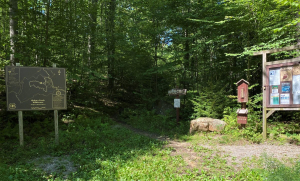
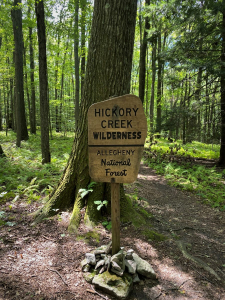
General Stand Condition
I spend a lot of time exploring bottomland hardwood forests near my home in northern Alabama, where understories are often dense with woody vegetation. The Hickory Creek forest floor istypically barren, carpeted fern-green on either side of the well-defined trail.
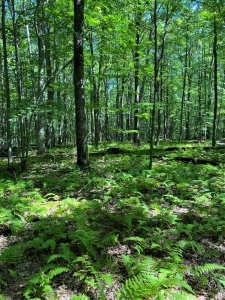
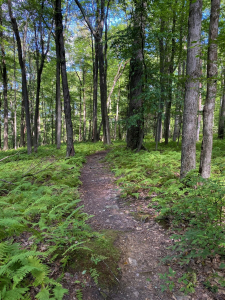
The climate is moist temperate, nearby Warren, PA averaging 47″ precipitation annually, evenly distributed across the seasons. Moss quickly colonizes fallen woody debris. Much cooler than northern Alabama, average July high temperature is 80 degrees; average January low is 15 degrees. Annual average snowfall is 100 inches. The same data points for Huntsville, Alabama are: 55″ precipitation; 90 July high; 30 January low; two inches of snow on average.
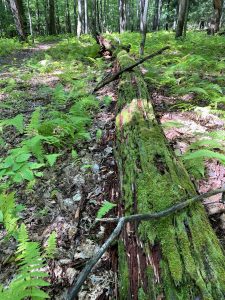
Species Composition
Black cherry is the signature species on these second growth Allegheny Hardwood forests. Black cherry, prized for its wood’s beauty and ease of working, is commercially in high demand. Nowhere else does this species grow better and of higher quality than on the Allegheny Plateau. The twin beauty below sports at least three 16-foot sawlogs below the first branch.
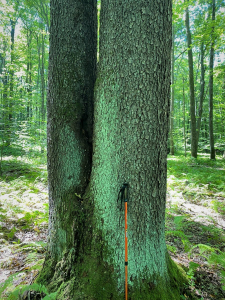
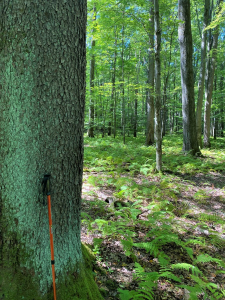
Red oaks (below) are common and, like the cherry above, grow straight and tall. Notice that the red oak (below left) is a twin; below right is a triple. Oaks often regenerate from stump or root sprouting. The twin and triplet suggest that the 90-or-so-year-ago harvest triggered sprouting from the stump of the harvested oak mother trees. Perhaps multiple sprouts generated…only two and three, respectively, survived nine decades.
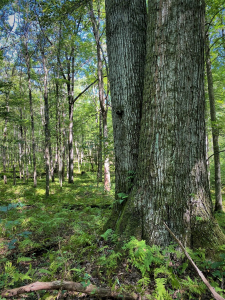
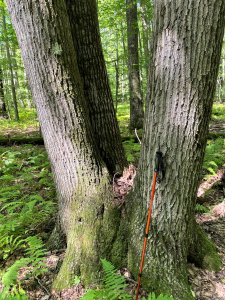
The chestnut oak below is also a double. All the oaks pictured reach high into the canopy. Multiple-stemmed main canopy trees are not unusual in these Allegheny forests, nor for our own northern Alabama upland and bottomland oaks. I am not suggesting that regeneration by seed (acorn) does not occur, nor that multiple stems derive from only logged stumps. Picture a healthy oak seedling clipped by a browsing deer. Oak resprouts vigorously after herbivory. Likewise, imagine a vigorous seedling or sapling charred by fire, killed from the root collar, then aggressively sprouting as a multiple-stemmed individual reaching skyward. Importantly, all stems in such clusters, whether in year one after sprouting or at age 90-years, are vegetatively reproduced, genetically identical, biological twins, triplets, etc.
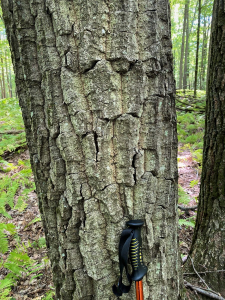
Cucumber tree (below) is a common, albeit minor, stand component.
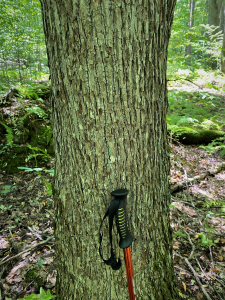
I found an occasional white pine. This individual stands as a dominant member of the main canopy. Unlike the barren (fern-covered) understory elsewhere, white pine regeneration (10-15-year-old saplings) offers promise within seed-fall of the mother tree.
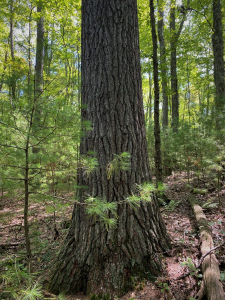
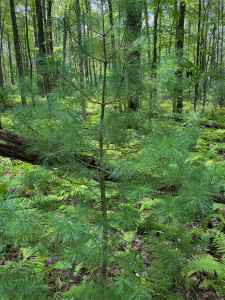
Nearby a small grove of hemlock likewise supports advanced hemlock regeneration. White pine and hemlock are shade tolerant when young, enabling advanced regeneration to patiently await crown openings or major forest disturbance.
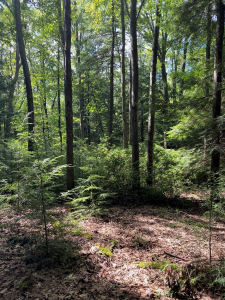
Tree Abnormalities
Red maple is another common Allegheny Hardwood component. This individual exhibited multiple woodpecker wounds (below left). The two close-up wounds below right appear to be kept active year after year. The larger wound is attempting to callous, yet both openings show recent and ongoing wounding.
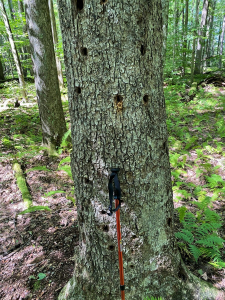
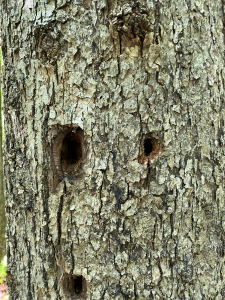
This tortured red maple, damaged severely as a sapling, manages to add enough annual wood to stay erect. Nature’s resilience, persistence, and adaptation never ceases to amaze me. This individual will never reach the main canopy (it occupies the intermediate canopy, the best it will ever do), nor will it live as long as its over-topping neighbors. However, it retains life and, were a major blowdown event to level the forest, this tree will produce stump sprouts that may surge ahead of its neighbor’s new shoots, perhaps assuring its next life could be lived in the dominant canopy. I’m assuming that this deformed iteration is owing to early physical damage and does not reflect some genetic predisposition to poor form.
Note once more the fern-dense forest floor, the result of decades of excessive deer browsing, which persists across the Allegheny Plateau.
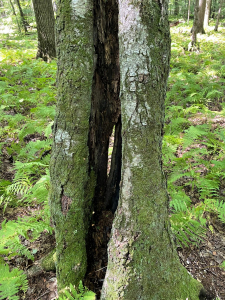
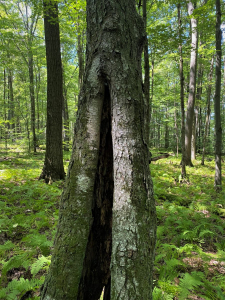
Excessive Deer Browsing
I did find woody regeneration within the fern cover, apparently hidden from browsing deer beneath the winter snowpack. Below left is blueberry, below right red maple.
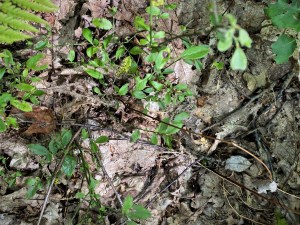

As well as red oak (left) and American beech (right).
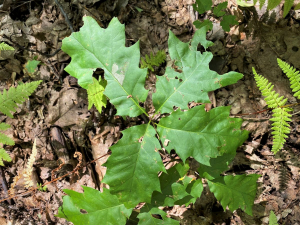
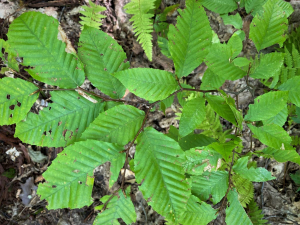
Their presence offers little promise of escaping the deer; however, they do evidence that seed is falling, germinating, and finding suitable soil to at least begin life. Over-browsing has presented a regeneration problem in these forests since well before I conducted my doctoral research in the mid-1980s.
Thoughts and Reflections
I offer these observations:
- Every forest has its story, read from a snapshot in time, deciphered from the observer’s experience and understanding of Nature’s language.
- Returning to a forest type I knew intimately a half century ago is akin to reminiscing with an old friend.
- Special places, I’ve learned, reside deep in our mind, heart, body, soul, and spirit.
Inhale and absorb Nature’s elixir. May Nature Inspire, Inform, and Reward you!
Note: All blog post images created & photographed by Stephen B. Jones unless otherwise noted. Please circulate images with photo credit: “©2021 Steve Jones, Great Blue Heron LLC. All Rights Reserved.”
Another Note: If you came to this post via a Facebook posting or by another route, please sign up now (no cost… no obligation) to receive my Blog Post email alerts: http://eepurl.com/cKLJdL
And a Third: I am available for Nature-Inspired Speaking, Writing, and Consulting — contact me at steve.jones.0524@gmail.com
Reminder of my Personal and Professional Purpose, Passion, and Cause
If only more of us viewed our precious environment through the filters I employ. If only my mission and vision could be multiplied untold orders of magnitude:
Mission: Employ writing and speaking to educate, inspire, and enable readers and listeners to understand, appreciate, and enjoy Nature… and accept and practice Earth Stewardship.
Vision:
- People of all ages will pay greater attention to and engage more regularly with Nature… and will accept and practice informed and responsible Earth Stewardship.
- They will see their relationship to our natural world with new eyes… and will understand more clearly their Earth home.
Tagline/Motto: Steve (Great Blue Heron) encourages and seeks a better tomorrow through Nature-Inspired Living!
Steve’s Three Books
I wrote my books Nature Based Leadership (2016), Nature-Inspired Learning and Leading (2017), and Weaned Seals and Snowy Summits: Stories of Passion for Place and Everyday Nature (2019; co-authored with Dr. Jennifer Wilhoit) to encourage all citizens to recognize and appreciate that every lesson for living, learning, serving, and leading is either written indelibly in or is powerfully inspired by Nature.
I began authoring books and Posts for several reasons:
- I love hiking and exploring in Nature
- I see images I want to (and do) capture with my trusty iPhone camera
- I enjoy explaining those images — an educator at heart
- I don’t play golf!
- I do love writing — it’s the hobby I never needed when my career consumed me
- Judy suggested my writing is in large measure my legacy to our two kids, our five grand kids, and all the unborn generations beyond
- And finally, perhaps my books and Blogs could reach beyond family and touch a few other lives… sow some seeds for the future


All three of my books (Nature Based Leadership; Nature-Inspired Learning and Leading; Weaned Seals and Snowy Summits) present compilations of firsthand experiences expressing my (and co-author Dr. Wilhoit for Weaned Seals and Snowy Summits) deep passion for Nature. All three books offer observations and reflections on my relationship to the natural world… and the broader implications for society. Order from your local indie bookstore, or find them on IndieBound or other online sources such as Amazon and LifeRich.

